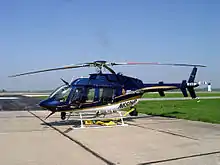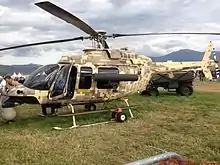Bell 407
The Bell 407 is a four-blade, single-engine, civil utility helicopter; a derivative of the Bell 206L-4 LongRanger. The 407 uses the four-blade, soft-in-plane design rotor with composite hub developed for the United States Army's OH-58D Kiowa Warrior instead of the two-blade, semi-rigid, teetering rotor of the 206L-4.
| Bell 407 | |
|---|---|
 | |
| Role | Multipurpose utility helicopter |
| National origin | United States/Canada |
| Manufacturer | Bell Helicopter |
| First flight | 29 June 1995[1] |
| Introduction | 1996 |
| Status | In service |
| Produced | 1995–present |
| Number built | 1,400+ (Dec 2017)[2] |
| Developed from | Bell 206L LongRanger |
| Variants | Bell ARH-70 Arapaho |
| Developed into | Bell 427 Northrop Grumman MQ-8C Fire Scout |
Design and development

In 1993, Bell began the development of the New Light Aircraft as a replacement for its Model 206 series. The program resulted in the 407, a development of Bell's LongRanger.[3] A 206L-3 LongRanger was modified to serve as the 407 demonstrator.[3] The demonstrator used hardware for the 407 and added molded fairings to represent the 407's wider fuselage then under development.[3]
The demonstrator was first flown on April 21, 1994, and the 407 program was publicly announced at the Heli-Expo in Las Vegas, Nevada, in January 1995.[3][4] The first 407 prototype (C-GFOS) accomplished its maiden flight on June 29, 1995, and the second prototype (C-FORS) followed on July 13, 1995. After a short development program, the first production 407 (C-FWQY/N407BT) flew on November 10, 1995.[1]
The Bell 407 features the four-blade main rotor developed for the OH-58D (Model 406). The blades and hub use composite construction without life limits, and provide better performance and a more comfortable ride. The 407's fuselage is 8 inches (20 cm) wider, increasing internal cabin space, and includes 35% larger main cabin windows. The more powerful Rolls-Royce/Allison 250-C47 turboshaft allows an increase in Maximum Takeoff Weight and improves performance at hotter temperatures and/or higher altitudes.[3] The 407's airframe is generally similar to the LongRanger, but includes a carbon fiber composite tailboom. The helicopter has standard seating for two crew and five cabin seats.[5]
The 407 was certificated by Transport Canada on February 9, 1996, with the FAA following shortly after on February 23.[1][6] Full production began in 1996 at Bell's Mirabel, Quebec, Canada plant and produced 140 airframes in 1997, to fill the initial orders.[5]
In 1995, Bell tested a shrouded tail rotor on the 407,[4] but did not proceed with it. For a time, Bell studied developing the Model 407T twin-engine variant, but instead chose to develop the essentially all-new twin-PW206D powered Bell 427.[3]
Bell began deliveries of the 407 in 1996. The 1,000th helicopter was delivered on June 15, 2010.[1]
ARH-70 and Bell 417
The ARH-70 armed reconnaissance helicopter, developed for the U.S. Army was based on the 407, but was later canceled on October 16, 2008.[7]
The Bell 417 was a growth variant of the Bell 407, in essence a civil version of the Bell ARH-70. The 417 made its first flight on June 8, 2006.[8] The 417 was to be powered by a Honeywell HTS900 turboshaft engine, producing 970 shp (720 kW) and includes full FADEC controls. The cabin sat five passengers in club-seating configuration, in addition to the crew of two.[9] The civilian 417 was canceled at Heli-Expo 2007 in Orlando.[10]
Bell 407GX and 407GT

On March 4, 2013, Bell unveiled a new armed version of the Bell 407GX, named the 407GT. It incorporates the Garmin G1000HTM flight deck to easily provide flight information. It can include infrared cameras, various armaments, and equipment to perform different missions such as armed transport, search-and-rescue, reconnaissance, and medical evacuation. The GT version uses the universal weapons pylon (UWP), derived from the Bell OH-58 Kiowa, to carry different weapons including machine guns, rockets, and anti-armor missiles.[11][12]
Operational history
Bell made delivery of the first production 407 at Heli-Expo, in Dallas, Texas in February 1996. Launch customers for the aircraft were Petroleum Helicopters, Niagara Helicopters, and Greenland Air.[1][13]
On 23 May 2007, Colin Bodill and Jennifer Murray completed a record pole-to-pole around the world flight using a standard Bell 407. The flight originated from Bell's facility at the Fort Worth Alliance Airport on December 5, 2006. The team flew about 36,000 miles (58,000 km) over 189 days and 300 flight hours, through 34 different countries. The project, named Polar First, was performed in partnership with the Royal Geographical Society to provide educational outreach to 28 international schools, which were visited during the trip. The project also served as a fundraiser for the SOS Children's Villages.[14]
In 2009 the Iraqi Air Force ordered three Bell 407 armed scout helicopters (similar to the canceled ARH-70).[15] A contract for 24 additional Bell 407s with an option for 26 more was awarded in April of that same year.[16] The U.S. Army is managing modifications and installation of military equipment on the helicopters.[17] Three training T-407s were delivered to the Iraqi Army in 2010. Armed IA-407s were delivered in eight batches of three aircraft from August 2012 to April 2013. The final Bell 407 for Iraq was delivered on 3 April 2013.[18] There are 30 in service; 24 armed scouts, three gunships, and three trainers.[19]
Iraq is using the IA-407 in operations against Islamic State militants. On October 8, 2014, militants shot down an IA-407 using a shoulder-fired ground-to-air missile, killing the pilot and co-pilot.[20]
In December 2017, more than 1,400 were operating.[2]
Variants

- Bell 407
- A civil utility helicopter, a derivative of the Bell 206L-4.[1]
- ARH-70
- An upgraded 407 version to serve as an armed reconnaissance helicopter.
- Bell 417
- Planned civil version of the ARH-70, was canceled.
- Bell 407 Light Observation Helicopter
- A military reconnaissance version.[5]
- Eagle 407 HP
- Version from Eagle Copter (Alberta, Canada) with a more powerful Honeywell HTS900 engine, rated at 1,021 shp (760 kW).[21][22]
- Northrop Grumman MQ-8C Fire Scout
- An unmanned aerial vehicle (UAV) version being developed by Northrop Grumman and Bell Helicopter as a cargo resupply demonstrator.[23][24][25] The test aircraft flew on 10 December 2010 at the Yuma Proving Ground.[26] In February 2011, the US Navy's budget request for 2012 included funds to buy 12 Fire-X helicopters under the designation MQ-8C.[27]

- Bell 407AH
- An armed civil-certified version for use with government and security forces.[28]
- Bell 407GX
- Version of the 407 that features the new Garmin G1000 H-model glass cockpit along with improved avionics and improved flight controls.[29]
- Bell 407GT
- Armed version of the 407GX.[11]
- Bell 407GXP
- Marketing designation for the 407 with Rolls-Royce 250-C47B/8 engine and Garmin G1000H avionics.[30]
- Bell 407GXi
- Marketing designation for the 407 with Rolls-Royce 250-C47E/4 engine and Garmin G1000H NXi avionics.
Operators
The Bell 407 is in civil service around the world with airlines, corporations, hospitals, government operators and private individuals. It is also in service with several military operators.
Military operators

Specifications (Bell 407)

Data from Bell 407[36]
General characteristics
- Crew: one pilot
- Capacity: Typical seating configuration for seven comprising pilot and passengers, with five passengers in main cabin / 2,347 lb (1,065 kg) internal payload / Max hook capacity 1,200 kg (2,646 lb).[3]
- Length: 41 ft 8 in (12.70 m)
- Height: 11 ft 8 in (3.56 m)
- Max takeoff weight: 6,000 lb (2,722 kg)
- Powerplant: 1 × Allison 250-C47B turboshaft engine, 813 shp (606 kW)
- Main rotor diameter: 35 ft 0 in (10.67 m)
- Main rotor area: 962 sq ft (89.4 m2)
- Blade section: - root: Boeing VR-7; tip: Narramore 8%[37]
Performance
- Maximum speed: 140 kn (160 mph, 260 km/h)
- Cruise speed: 133 kn (153 mph, 246 km/h)
- Range: 324 nmi (373 mi, 600 km)
- Service ceiling: 18,690 ft (5,700 m)
See also
- N31VA, a Bell 407 that crashed in 2017
Related development
Aircraft of comparable role, configuration, and era
- AgustaWestland AW119
- Eurocopter AS350
- Eurocopter EC120
- Eurocopter EC130
- Marenco SKYe SH09
- MD Helicopters MD 600
- Kazan Ansat
References
- "Bell 407". Jane's All the World's Aircraft. Couldson, Surrey, UK: Jane's Information Group, 2010. subscription article, posted September 13, 2010.
- Mark Huber (December 13, 2017). "Bell Canada Delivers 5,000th Civil Helicopter". AIN.
- Frawley, Gerard. The International Directory of Civil Aircraft, 2003-2004, p. 47. Aerospace Publications Pty Ltd, 2003. ISBN 1-875671-58-7.
- "Bell launches Model 407". Flight International, February 8, 1995.
- "Bell 407". Jane's Helicopter Markets and Systems. Couldson, Surrey, UK: Jane's Information Group, 2010. subscription article, posted April 13, 2010.
- "Bell Helicopter 407" Archived February 3, 2010, at the Wayback Machine. Flug Revue, March 19, 2001.
- "Dod Announces Non-Certification Of Armed Reconnaissance Helicopter Program". defenselink.mil. Archived from the original on 22 October 2008. Retrieved 2008-10-17.
- "Bell 417 achieves first flight". Rotorbreeze. Vol. 55 no. 3. October 2006. p. 12.
- "Bell Helicopter Unveils New Bell 417". textron.com. Archived from the original on 24 November 2006. Retrieved 2006-11-09.
- "Bell Scraps Year-Old 417, Finding No Market". aviationtoday.com. Retrieved 2007-06-03.
- "Bell Helicopter Introduces Increased Mission Capability with the Bell 407GT" Archived 2013-03-15 at the Wayback Machine. Bell Helicopter, March 4, 2013.
- "BAE’s APKWS rockets integrated on Bell’s new Model 407GT". Flightglobal.com, March 5, 2013.
- "History of the Bell Helicopter 407" Bell Helicopter. Archived September 22, 2010, at the Wayback Machine.
- "Polar First Sets World Record". Rotorbreeze. July 2007.
- "Bell 407s Ordered for Iraq". Air International, April 2009, Vol 76, No. 4. p. 7.
- "Bell Helicopter Sells 24 Model 407 Helicopters Destined for Iraqi Air Force" Archived May 8, 2009, at the Wayback Machine. Bell Helicopter, April 29, 2009.
- "Huntsville Times", pp. A1, A10. November 29, 2009. online version.
- Army makes final delivery of IA-407s to the Iraqis - Army.mil, 21 May 2013
- "More For The Iraq Army Air Corps". Strategypage.com, January 29, 2013.
- "IS downs another Iraqi helicopter". Armytimes.com, 8 October 2014
- "Honeywell Announces HTS900 Engine Upgrade For Bell 407 Operators". Honeywell, February 21, 2010.
- Thurber, Matt. "Eagle 407 soars with Honeywell engine". ainonline.com, February 21, 2010.
- Trimble, Stephen. "Northrop offers Fire-X concept for unmanned resupply". Flightglobal.com, May 4, 2010.
- Warwick, Graham."Northrop, Bell Power Up Unmanned Fire-X" . Aviation Week, September 30, 2010.
- "Fire-X Vertical Unmanned Aircraft System" video. Northrop Grumman media via youtube.com. Retrieved: 11 October 2010.
- "Archived copy". Archived from the original on 2010-12-29. Retrieved 2011-01-13.CS1 maint: archived copy as title (link)
- Warwick, Graham. "U.S. Navy Wants Larger Fire Scout Airframe". Aviation Week, February 17, 2011.
- Trimble, Stephen. "Bell Helicopter unveils first certified armed 407s" Flight International, March 8, 2011.
- Pope, Stephen (June 9, 2011). "Bell 407GX". Flying Magazine.
- "Bell 407GXP". Bell.
- "Bell 407 Seven-Seat Light Helicopter". aerospace-technology.com. Retrieved 2013-02-05.
- Stephen Carlson (July 11, 2017). "Bell Helicopter receives Iraqi air force maintenance contract". UPI.
- "World Air Forces 2013" (PDF). Flightglobal Insight. Retrieved 2013-06-02.
- "World Air Forces 2018". Flightglobal Insight. 2018. Retrieved 4 August 2018.
- "World Air Forces 2021". FlightGlobal. 4 December 2020. Retrieved 5 January 2021.
- "Product Specifications: Bell 407". bellhelicopter.com. Archived from the original on 2 March 2008. Retrieved 2008-03-05.
- Lednicer, David. "The Incomplete Guide to Airfoil Usage". m-selig.ae.illinois.edu. Retrieved 16 April 2019.
Further reading
- "Revelations of 'El Chapo' Guzmán's personal pilot". Univision. January 30, 2017. (El Chapo bought a Bell 407 helicopter on the advice of his personal pilot.)
External links
| Wikimedia Commons has media related to Bell 407. |
- Bell 407GXP page on BellHelicopter.com site
- Alexa Rexroth (August 16, 2018). "Pilot Report: Bell 407GXi". AIN online.